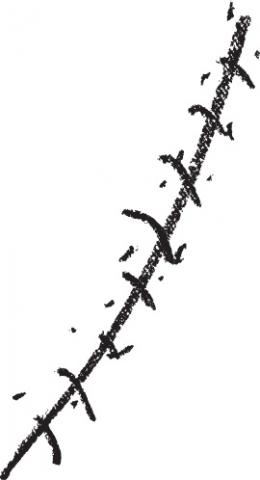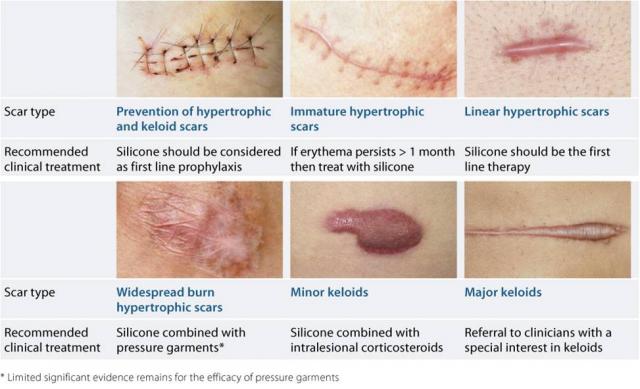"/>
Current Treatments


This website has been possible due to an Educational grant provided by Sinclair Pharmaceuticals, providers of Kelo-Cote scar Gel. We would like to thank Sinclair Pharmaceuticals for thier generous support

Products with Evidence:
Treatments for scars, have been around since the 1970's, when silicone sheets were first used in burn patients. Since then the treatments have evolved. Some of the current treatments are proven to be effective in controlled clinical studies and others have not. This site does not recommend treatments, but does point out the evidence available for the various treatments. In some cases there is no real clinical data and we will also highlight this.
The majority of evidence for the treatment and prevention of scars is for the use of silicone. Silicone was found to be an effective treatment, which was confirmed in the definitive 2002 study from the USA (Mustoe et Al), which reviewed all the available clinical data and came out with recommendations for the treatment of scar. These recommendations still hold today.
As can be seen for the different type of scars below, silicone is recommend as first line treatment for scars of all types, sometimes in combination with other therapies.
Silicone is avaliable in three main different presentations;
1- Silicone Sheets. These are thick sheets of silicone that are taped onto the body and have to be used for 3 months. They are proven to be effective and were the main form of treatment for scars until recently.
2. Silicone Gel. This presentation has now taken over as the main form of silicone for use on the treatment and prevention of scars. It is available in a tube format for simple application and in some cases will dry onto the skin within minutes so that sun screen and cosmetics can be applied if needed. The self drying silicone is available from our sponsors (see above) and most of the treatments are also available on prescription. Kelo-cote has over 2500 patients treated under clinical trials, which is why it tends to be used by the medical profession.
3. Silicone Spray. This is a new innovation that allows the application of silicone onto larger areas. It is used extensively for burns patients, as the scars tend to be over a larger area and are sometimes painful to touch.

The treatment of Keloids tends to be more problematic than other scars and there is a great deal of research going on to find effective treatments for Keloids. Silicone gels are used extensively but a few other treatments are highlighted below;
Corticosteroid Injections. These are not steroids that you hear about on the news, but are used extensively in medicine to reduce inflammation. Steroid injections have good clinical data backing them up, but most people who have had them complain that they hurt. Corticosteroid injections are considered the first line of therapy for Keloids
Surgery. Keloid scars can be removed surgically, but unless done by a physician who has operated on keloids before, then they tend to come back, sometimes bigger than before. With careful surgery from experienced Doctors and follow up treatment with pressure and silicone the chance of the Keloid coming back is minimized.
Laser Treatment. Lasers have been used for some time to treat scars and have a proven effect at reducing the redness of scars, particualry Keloids. There is little data at the moment showing that lasers reduce the volume of scars, but research is on-going.

There are several products currently in research that have had good initial outcomes, particularly in Keloids.
Imiquimod Cream. Used mainly as a treatment for skin cancer, has had some initial success in the treatment of Keloids after surgery to remove the Keloid. Further work is on-going.
Bleomycin. Used as a treatment for cancer, The initial results were promising, but there were side effects such as hair loss in a large number of patients studied.
5-Flurouracil. As with Bleomycin, used as a treatment for skin cancer. Similar results were see as with Bleomycin.
Products with no evidence.
There are lots of treatments sold that have no proven difference in treating scars than doing nothing, or massage with a moisturizer. Yet these products are bought extensively for their use on scars.
Vitamin E. In a topical format, No difference has been see in studies with no treatment and about 20% of people complain about skin itching as a result of the use of Vitamin E.
Onion Oil Extract. This is widely used in some countries yet repeated clinical studies, show no difference between the use of onion oil extract moisturising creams, or petroleum jelly.
Essential Oil based products. Becoming popular in the treatment of scars, yet there is no good data to back up the claims that it works effectively at treating scars. The oils can irritate the skin in some instances.
Complimentary Treatments.
Massage. Massage is used a lot in burn centers, where it is felt that the addition of the moisture from the cream and also the massage effect itself, compliments the other therapies. It is usually recommended in conjunction with other treatments, particularly silicone gel, which is applied after the scar has been massaged and dried.
Pressure Garments. Pressure garments have been used since the 60's to treat patients with large burns. Measurements are take of the individual in the same way that you are measured for clothing and then a flexible garment is made for the area that is effected which is 15% or so smaller than the initial measurement. Recent studies have suggested the use of pressure garments is no better than conventional therapy (massage plus silicone) but this is only one study and the garments are still used.